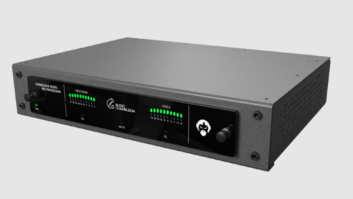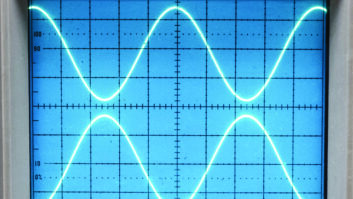Prime Image manufactures the Time Tailor Audio, a live program time-reduction device intended to create additional time without data compression. It’s able to do this without pre-recording, pre-processing, compromising the fidelity or changing the pitch (frequency) of the audio; and, within parameters, without artifacts.
(click thumbnail)Time Tailor Audio
Though a single rack-space unit, it’s deep and very heavy. It also houses a loud fan, which forced me to remote it to the airlock outside my studio. My demo unit offered only XLR analog in and outs. The front panel offers a Mode button for selecting the three parameters – audio level, time adjustments and preferences. The Set + and – buttons adjust these choices, and the LCD screen reveals your settings. There are four memory slots (F1-F4), and a set of Hold and Stop buttons which, when held down simultaneously, allow you to back out of any settings you have made.
The literature promotes the unit’s main function like this: Typically a radio broadcast time slot allows all the way up to 30 minutes of finished program content per half-hour block. When local broadcasters rerun the shows, the program time allotment will probably need to be reduced by an unknown amount for insertion of commercials, promo spots and public service announcements.
Previous methods of compressing the running time included editing out audio, dropping credits or even playing the show at a greater than normal speed, resulting in a pitch change or other noticeable artifacts.
The Prime Image Time Tailor allows an operator to determine how much time is needed to be freed up during the programming block, and to activate the Time Tailor at the time of broadcast to nibble away at the program in microseconds and milliseconds, until the desired new length is achieved, permitting a new block of programming to be produced on the fly.
Up to speed
Let’s use a 30-minute spoken word block as a demonstration example. The program is 29:59, and the station needs to run 90 seconds of commercials at the beginning of the block. The operator routes the program through the Time Tailor (preset to add 90 seconds of silence to the 29:59 finished program and routed to air), then sets up his 60-second and his 30-second commercials directly to air.
At the prescribed time, the tech would hit the Start button of the Time Tailor, the first sixty-second commercial and the full 29:59 minute finished program, all at the same time. The commercial would be heard (since it’s routed straight to air); the full program would be playing into the Time Tailor (but no audio would be coming out of it).
At the end of the 60-second commercial, the tech plays the next 30-second commercial (again, routed directly to air); the 29:59 finished program is still playing, but still no audio is heard. At the end of the 30-second commercial, the 29:59 program begins to play out of the Time Tailor, and 28 minutes and 29 seconds later it would finish.
Curious minds want to know, will it take six minutes out of a 12-minute piece? The answer is yes, but now our spoken word piece is starting to sound like we’ve had substantially too much stress today and we just want to get out of the studio.
There also is damage to the frequency response, potentially so much so that Prime Image has included a “Q” factor display that reveals a fidelity remaining “percentage”; in other words, the pristine 100 percent audio begins to lose percentage points as the time-reducing process eats away at presence, and eventually, overall frequency response.
Now, as an audio guy, I have to say my interest (and admiration for this invention) is for yet another function entirely. Once assigned a length of time for my piece, commentary or segment to run, I have to edit, rewrite, revise or alter my performance to get it to time. I could end up as much as 30 seconds long on an 18-minute segment. No problem.
I can get it to time with a brief data-entering session with the Time Tailor. I tell the device how many seconds to remove, start a recorder connected to the output of the Tailor, and the recorder captures a perfect-time production with no discernable change. The unit is extremely transparent to my ear, with none of the glitches I’m used to using other time compressors. As a production person, this is an indispensable tool that saves me much reliance on my wit to complete my project.













